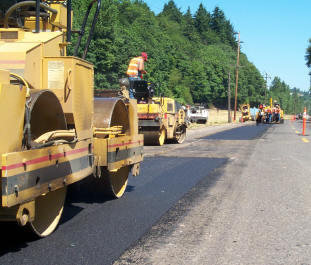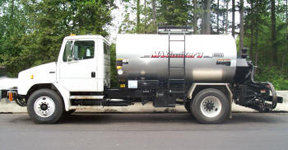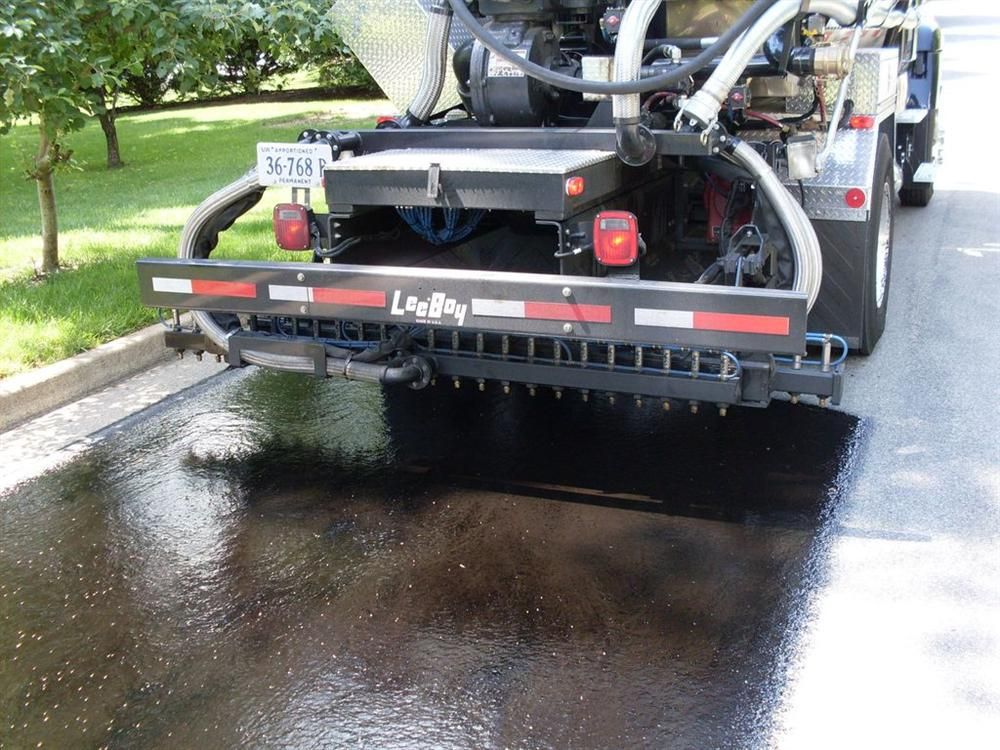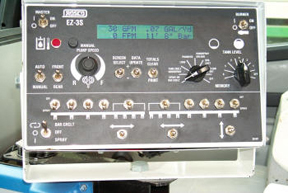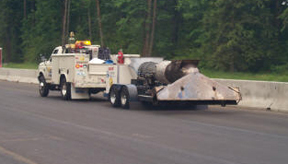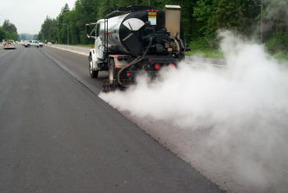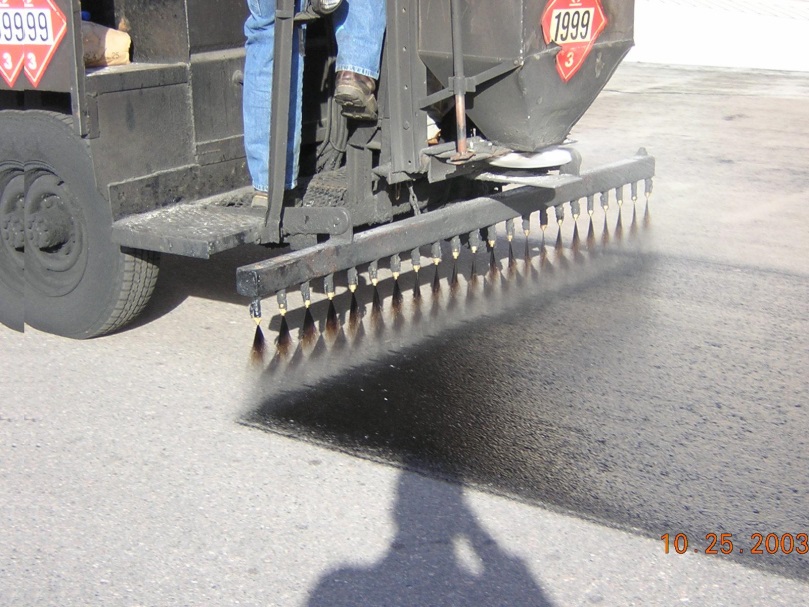Section 3: Pavement Surface Preparation
Anchor: #i10245073.1 Surface Condition
The performance of a flexible pavement under traffic is directly related to the condition of the surface on which the pavement layers are placed. For a full-depth asphalt pavement, if the condition of the subgrade soil is poor, the ultimate durability of the roadway may be reduced. For hot-mix asphalt (HMA) layers placed on top of a new, untreated granular base course, the base material should not be distorted by the trucks carrying the mix to the paver. For HMA placed as an overlay on top of an existing HMA layer, the surface should be free of major distresses, smooth and clean.
Anchor: #i10245623.2 Prime Coat - Flexible Pavements
For flexible pavements, the graded subgrade or the top granular base layer may be prepared with a prime coat. A prime coat is a sprayed application of a cutback asphalt or asphalt emulsion (AE) applied to the surface of untreated subgrade or base layers. The prime coat serves several purposes:
- Anchor: #PDCVBBCL
- fills the surface voids and protects the base from weather, Anchor: #DEIGHRDW
- stabilizes the fines and preserves the base material integrity, and Anchor: #JCENKESV
- promotes bonding to the subsequent pavement layers.
The project plans specify the rate at which the prime coat is applied, and rates will vary from one project to another. Generally, however, medium curing cutback asphalt is applied at a rate between 0.2 to 0.5 gal./SY, and emulsified asphalts are applied between 0.1 to 0.3 gal./SY. For emulsions, it is recommended to cut-in the emulsion with the top 1 in. of the base. Alternately, cutting in 50% of the prime into a surface of cement-treated base, followed by compaction and application of the remaining 50% has shown to be beneficial in bonding of subsequent bituminous layers.
Anchor: #i10246583.3 Underseals
Preparation of a primed soil/aggregate base surface or an existing asphalt-surfaced pavement for an overlay typically includes an underseal which is a sprayed application of asphalt binder (asphalt emulsion or hot applied asphalt binder) immediately covered by a layer of single-sized aggregate. The underseal provides several benefits, such as waterproofing the surface, sealing small cracks, and protecting the underlying surface from solar radiation. The application of an underseal should be strongly considered when placing a thin ACP layer on top of a flexible base. The “Seal Coat and Surface Treatment Manual” covers in detail the design and construction of seal coats.
Anchor: #i10247623.4 Seal Coats
For new or reconstructed pavements, the seal coat can be placed on a crushed stone or chemically treated base to provide a roadway with the least expensive permanent type of bituminous surface. Seal coats seal and protect the base and provide strength at the road surface so that the base can resist the abrasive and disruptive forces of traffic. Often these surfaces are placed in multiple treatments of two or three placements of successively smaller rock to enhance durability and reduce tire noise. A prepared road base structure that is to be surfaced using the seal coat concept should always be primed first. The asphalt in the prime should be compatible with the binder used to create the seal coat. Seal coats have been used successfully on both low- and high-traffic volume roadways, but tend to be more successful on low-volume roadways, especially low-volume truck traffic. Use of hot PG, polymer-modified, or asphalt rubber binders with larger grade rock (Grade 2 or 3) can improve the performance of seal coats under higher truck traffic conditions. The use of seal coats in urban areas where accelerating/decelerating traffic and turning movements frequently occur should be approached with caution. Binder application rates vary in accordance with the type/size of the treatment rock being placed, type of binder used, the level of traffic, and the condition/texture of the existing surface. See the Seal Coat and Surface Treatment Manual for guidelines and methodologies for design of binder and aggregate application rates.
Anchor: #i10258533.5 Existing Surface Preparation for Overlays
Overlays make up a large portion of the roadway paving done today. The degree of surface preparation for an overlay is dependent on the condition and type of the existing pavement. The existing pavement should be structurally sound, level, clean and capable of bonding to the overlay. To meet these prerequisites, the existing pavement is usually repaired, leveled (by milling, applying a level-up course or both), cleaned, and then coated with a binding agent. This subsection covers:
- Anchor: #KVFNBCYF
- repair, Anchor: #URGHVAYI
- tack coats.
3.5.1 Repair
Generally, pavement overlays are used to restore surface course functional characteristics (smoothness, friction, and aesthetics) or add structural support to an existing pavement. However, even a structural overlay should be placed on a structurally sound base. If an existing pavement is cracked or provides inadequate structural support, these defects will eventually reflect through even the best-constructed overlay and cause premature pavement failure in the form of cracks and deformations. To maximize an overlay’s useful life, failed sections of the existing pavements should be patched or replaced and existing pavement cracks should be filled.
Figure 6-2. Repairing Failed Pavement Sections before Overlay.
At most, overlays are designed to add only some structural support; the remaining structural support must reside in the existing pavement. Therefore, small areas of localized structural failure in the existing pavement should be repaired or replaced to provide this structural support (see Figure 6-2). Often, existing pavement failure may be caused by inadequate subgrade or flex base support, or poor drainage. In these cases, the existing pavement over the failed area should be removed full depth and the subgrade should be prepared as it would be for a new pavement (Item 351, “Flexible Pavement Structure Repair”).
Existing pavement crack repair methods depend upon the type and severity of cracks. Badly cracked pavement sections, especially those with pattern cracking (e.g., fatigue cracking) must be patched or replaced because these distresses are often symptoms of more extensive base or subgrade structural failure. Existing cracks other than those symptomatic of structural failure should be cleaned out (blown out with pressurized air and/or swept) and filled with a crack-sealing material when the cracks are clean and dry. Cracks less than about 3/8 in. in width may be too narrow for crack-sealing material to enter. These narrow cracks can be widened with a mechanical router before sealing. Swelling of crack sealant may occur particularly under newly placed thin HMA overlays, causing a bump at these locations. Use of WMA with their lower placement temperatures may mitigate this problem.
If the existing pavement has an excessive amount of fine cracks but is still structurally adequate, it may be more economical to apply a seal coat or slurry/scrub seal instead of filling each individual crack. Also, these situations may lend themselves to using a spray-paver where a relatively heavy emulsion is applied concurrently with the overlay.
In summary, pavement repair should be extensive enough to provide an existing pavement with adequate structural support. Pavement management techniques should provide for overlays before an existing pavement has lost most or all of its structural support capability.
3.5.2 Tack Coats
A tack coat material can be a PG binder or an emulsion layer applied between HMA pavement lifts to promote bonding. Adequate bonding between constructed lifts (especially between the existing road surface and an overlay) is critical for the constructed pavement structure to behave as a single unit and provide adequate strength. If adjacent layers do not bond to one another, they essentially behave as multiple independent thin layers − none of which are designed to accommodate the anticipated traffic-imposed bending or near surface shear stresses. Inadequate bonding between layers can result in delamination (debonding) followed by longitudinal wheel path cracking, alligator cracking, potholes, and other distresses, such as rutting, that greatly reduce pavement life.
3.5.2.1 Application
Tack coats should be applied uniformly across the entire pavement surface and result in more than about 90% surface coverage. In order for this uniformity to be consistently achieved, all aspects of the application must be considered and carefully controlled. Specific aspects are:
- Anchor: #KTRSFBCJ
- the condition of the pavement surface receiving the tack coat, Anchor: #FQGWOJLS
- the application rate, and Anchor: #NTNNRLBO
- the type of tack coat according to standard TxDOT specifications on Item 330, “Limestone Rock Asphalt Pavement,” and hot-mix items 334, 340, 341, 342, 344, 346, and 347.
3.5.2.2 Condition of the Pavement Surface Receiving the Tack Coat
The pavement surface receiving the tack coat should be clean and dry to promote maximum bonding. Emulsified tack coat materials may be applied to cool and/or damp pavement; however, the length of time needed for the set to occur may increase. Since existing and milled pavements can be quite dirty and dusty, their surfaces should be cleaned off by sweeping or washing before any tack coat is placed, otherwise the tack coat material may bond to the dirt and dust rather than the adjacent pavement layers. This can result in excessive tracking of the tack coat material. Construction vehicles and equipment pick up the tack-dirt mixture on their tires and leave the existing roadway with little or no tack coat in the wheel paths (see Figure 6-3). Slippage cracking and delamination are distresses typically seen when cleanliness is lacking.
Figure 6-3. Tack coat tracking resulting in no tack coat in the wheel path. © Copyright 2006 University of Washington
3.5.2.3 Application Rate
Tack coat application should result in a thin, uniform coating of tack coat material covering approximately 90% of the pavement surface (Flexible Pavements of Ohio, 2001). To achieve this result, application rate will vary based on the condition of the pavement receiving the tack coat. Too little tack coat can result in inadequate bonding between layers. Too much tack coat can create a lubricated slippage plane between layers or can cause the tack coat material to be drawn into an overlay, negatively affecting mix properties and even creating a potential for bleeding in thin overlays (Flexible Pavements of Ohio, 2001). Table 6-1 shows recommended application rates from Flexible Pavements of Ohio (2001.)
|
Existing Pavement Condition
|
Application Rate (gal/SY) |
|
|---|---|---|
|
Residuala |
Undilutedb |
|
|
New HMA |
0.03 - 0.04 |
0.05 - 0.07 |
|
Oxidized HMA |
0.04 - 0.06 |
0.07 - 0.10 |
|
Milled HMA |
0.06 - 0.08 |
0.10 - 0.13 |
|
Milled PCC |
0.06 - 0.08 |
0.10 - 0.13 |
|
PCC |
0.04 - 0.06 |
0.07 - 0.10 |
|
aResidual: The application rate of just the asphalt binder content of the emulsion. bUndiluted: The application rate of the Undiluted emulsion. |
||
Basic application rate considerations are:
- Anchor: #EOFBFDAX
- Roughness of the pavement surface receiving the tack coat. Rough surfaces require more tack coat than smooth surfaces. For instance, milling produces a rough, grooved surface, which will increase the existing pavement’s surface area when compared to an ungrooved surface. The surface area increase is dependent on the type, number, condition, and spacing of cutting drum teeth, but is typically in the range of 20 to 30%, which requires a corresponding increase in tack coat (20 to 30% more) when compared to an unmilled surface (TRB, 2000). Anchor: #WBTSRCCV
- Distributor vehicle.
Several vehicle-related adjustments and settings are critical to
achieving uniform tack coat placement. Essentially, the nozzle patterns,
spray bar height, and distribution pressure must work together to
produce uniform tack coat application. Generally, the best applications
result from a "double lap" or "triple lap" coverage. "Double/triple
lap" means that the nozzle spray patterns overlap one another such
that every portion of the pavement receives spray from exactly two/three
nozzles (see Figure 6-4, Figure 6-5, Figure 6-6, Figure 6-7, Figure 6-8,
Figure 6-9, and Figure 6-10). Specific guidance follows:
- Anchor: #DBBSXXNO
- Nozzle spray patterns should be identical to one another along a distributor spray bar. Differing coverages will result in streaks and gaps in the tack coat. Anchor: #WBOQWEAS
- Spray bar height should remain constant. As tack coat is applied, the vehicle will become lighter, causing the spray bar to rise. The tack coat application vehicle should be able to compensate for this. Excessively low spray bars result in streaks, while excessively high spray bars cause excessive nozzle overlap, resulting in an excessive application rate. Anchor: #QTHFHEQP
- Pressure within the distributor must be capable of forcing the tack coat material out the spray nozzles at a constant rate. Inconsistent pressure will result in non-uniform application rates. Anchor: #VWBUBAYP
- Temperature within the distributor should be maintained between 24°C (75°F) and 54°C (130°F). Excessive heating may cause the emulsion to break while still in the distributor.
Figure 6-4. Tack coat application using double lap coverage. © Copyright 2006 University of Washington
Figure 6-5. Tack Coat Distributor Truck. © Copyright 2006 University of Washington
Figure 6-6. Tack Coat Distributor Truck Spray Bar. © Copyright 2006 University of Washington
Figure 6-7. Tack Coat Distributor Control Panel. © Copyright 2006 University of Washington
Figure 6-8. Jet dryer used ahead of the tack coat distributor. © Copyright 2006 University of Washington
Figure 6-9. Tack coat application. © Copyright 2006 University of Washington
Figure 6-10. Tack coat application showing nozzle coverage area. © Copyright 2006 University of Washington
3.5.3 Other Tack Coat Aspects
3.5.3.1 Timing
Generally, a tack coat should be allowed enough time to break and set (emulsion) before applying the next layer of hot-mix asphalt (HMA).
3.5.3.2 Tracking
Tracking is the pick-up of tack coat material by vehicle tires. Tracking deposits tack coat material on adjacent pavement surfaces. Although this material is unsightly, it generally has little effect and wears away quickly. In extreme cases, tracking may deposit enough tack coat material to distort pavement surfaces or hinder a driver's ability to navigate (Flexible Pavements of Ohio, 2001). Rubberized tack coats have an especially high propensity to stick to vehicle tires. More critical to long-term pavement performance is that any tack removed by tracking from construction or other vehicular traffic implies that the tack is no longer available to stick the new overlay to the existing surface. This can become extremely critical in cases of HMA delivery trucks tracking tack out of the wheel paths while in the process of their delivery in front of the paving machine. This sets up the worst possible scenario of removing tack from the most critical part of the pavement structure directly subject to the shearing action of traffic wheel loads. Allowing tack coats to set (emulsions) before driving on them can substantially reduce tracking. Also, new “trackless” emulsion products that dry very quickly, but are reactivated by the heat of the newly placed HMA, are worth consideration when tracking may be an issue.
Generally, traffic should not be allowed on tack coats. When a tacked road surface is exposed to traffic, the potential exists for reduced skid resistance, especially during wet weather (Flexible Pavements of Ohio, 2001). When tack coat surfaces must be opened to traffic, they should be covered with sand to provide friction and prevent pick-up. A typical rate for applying a sand cover is 4 to 8 lb./SY (Flexible Pavements of Ohio, 2001).
